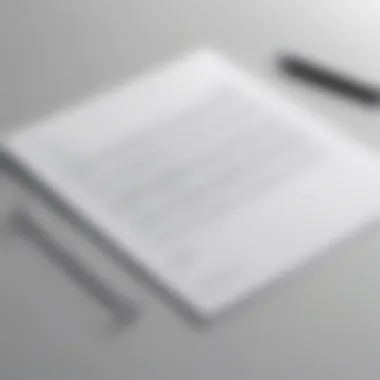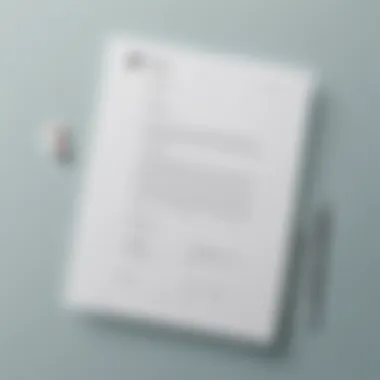Crafting a Professional Resignation Letter: Guidelines and Sample Template


In the realm of professional decorum, the art of composing a well-crafted resignation letter holds paramount significance. Beyond a mere formality, a resignation letter serves as a testament to one's professionalism, encapsulating the essence of departing a role with grace and integrity. Whether you find yourself navigating the delicate process of resigning from a job or position, this comprehensive guide seeks to equip you with the essential tools to articulate your resignation effectively.
How to Approach Your Resignation Letter
Initiating the process of crafting a resignation letter necessitates a strategic approach. Begin by setting a contemplative tone, acknowledging your decision to depart conscientiously. Employ a concise yet expressive language to convey your intentions clearly. It is crucial to strike a balance between professionalism and personal touch, ensuring your sincerity resonates in every word penned.
Structuring Your Resignation Letter
The structure of your resignation letter plays a pivotal role in conveying your message effectively. Commence with a cordial salutation, addressing the recipient with respect and courtesy. Subsequently, articulate the purpose of your letter succinctly, delineating your intention to resign from your current position. Follow this declaration with a brief expression of gratitude for the opportunities and experiences garnered during your tenure.
Afterwards, offer a concise explanation for your decision to resign, refraining from delving into intricate details or negative sentiments. Maintain a forward-looking approach, focusing on future endeavors and the growth opportunities ahead. Conclude your letter gracefully, extending well wishes to the organization and affirming your commitment to ensuring a smooth transition.
Incorporating Sample Phrases
Drawing inspiration from sample phrases can aid in articulating your thoughts seamlessly. Consider incorporating phrases such as 'I am grateful for the support and guidance received,' 'I have grown both professionally and personally,' and 'I am eager to embark on new challenges and opportunities.' These phrases lend a polished and diplomatic touch to your resignation letter.
Seeking Feedback and Revision
Before finalizing your resignation letter, solicit feedback from trusted colleagues or mentors. Peer review can offer valuable insights into refining your message and ensuring it aligns with your intended tone. Embrace constructive criticism and be open to incorporating suggestions for enhancement, enhancing the overall impact of your resignation letter.
Synthesizing Your Resignation Letter
In essence, crafting a professional resignation letter is an art form that demands meticulous attention to detail and sincere reflection. By adhering to the guidelines presented in this comprehensive guide, you can navigate the process of resigning with poise and professionalism. Remember, your resignation letter serves as a legacy of your tenure, encapsulating your dedication and gratitude towards your professional journey.


Introduction
Crafting a professional resignation letter is a crucial component of exiting a job or position with grace and professionalism. Understanding the importance of a well-crafted resignation letter sets the tone for a respectful departure and leaves a lasting impression on your soon-to-be former colleagues and superiors. This article serves as a comprehensive guide to help individuals navigate the intricacies of drafting a resignation letter effectively. By following the advice and sample provided in this article, readers can elevate their resignation process to reflect the utmost professionalism.
In today's dynamic work environment, where transitions between jobs and positions are commonplace, the manner in which one resigns plays a significant role in shaping their professional reputation. A well-written resignation letter not only serves as a formal notice of departure but also reinforces professional etiquette and respect for the organization. Furthermore, a carefully crafted resignation letter can help in maintaining positive relationships with former employers and colleagues, which may prove beneficial in the future.
Among the key purposes of a resignation letter is to provide a formal record of the employee's decision to resign. This document serves as a tangible proof of the resignation date, which can be crucial for both the employee and the employer in matters such as final pay, benefits, and the transition of responsibilities. Additionally, a resignation letter establishes clarity and transparency in communication, ensuring that all parties involved are on the same page regarding the departure process.
By upholding professional etiquette and respect through a well-worded resignation letter, individuals demonstrate their maturity and commitment to handling professional relationships with care and consideration. A resignation letter that conveys gratitude for the opportunities provided, expresses appreciation for the learning experiences gained, and offers assistance in the transition period reflects a sense of integrity and professionalism.
From a legal perspective, a resignation letter serves as a formal notification to the employer, fulfilling the necessary requirements for ending the employment contract. By following a structured format and including essential details in the resignation letter, individuals can ensure that the resignation process adheres to legal formalities, minimizing the risk of misunderstandings or disputes. Therefore, understanding the legal implications and formality associated with resigning through a well-written letter is paramount in protecting one's professional interests and maintaining a positive reputation.
Understanding the Importance of a Resignation Letter
Crafting a professional resignation letter is a crucial step in the process of leaving a job or position. It serves as a formal communication to your employer about your decision to resign and signifies your commitment to a professional and respectful separation. Understanding the importance of a resignation letter involves recognizing its value in maintaining good relationships, preserving professional integrity, and ensuring a smooth transition. By comprehending the significance of this document, individuals can navigate the resignation process with clarity and maturity, showcasing their commitment to professionalism.
Key Purposes of a Resignation Letter
A resignation letter serves multiple key purposes in the realm of professional etiquette. Firstly, it acts as a formal notification of intent to resign, clearly stating the individual's decision to leave their current position. Additionally, it provides a written record of the resignation, documenting the exact date of notification and the anticipated last day of work. This helps in avoiding any miscommunication or misunderstandings regarding the departure timeline, ensuring a transparent and organized exit process. Moreover, a resignation letter conveys gratitude and appreciation towards the employer and colleagues, fostering positive closure and leaving a lasting impression of professionalism.
Professional Etiquette and Respect
Professional etiquette and respect are fundamental aspects of crafting a resignation letter. Demonstrating courteous behavior and gratitude towards the employer and team members reflects positively on the individual's professionalism and character. By adhering to proper etiquette in the resignation letter, such as maintaining a respectful tone, expressing gratitude for opportunities, and offering assistance during the transition period, individuals can leave a lasting impression of integrity and maturity. Resigning with grace and respect not only preserves relationships but also upholds one's professional reputation in the industry.


Legal Implications and Formality
From a legal standpoint, a resignation letter holds significant importance as it serves as a formal document acknowledging the voluntary termination of employment. By submitting a resignation letter, individuals comply with legal requirements and formalities related to resigning from a job. This document assists in clarifying responsibilities, ensures adherence to notice periods or contractual obligations, and protects the rights of both the employee and the employer. Understanding the legal implications of a resignation letter is essential to navigate the process with compliance and professionalism, mitigating any potential conflicts or misunderstandings.
Components of an Effective Resignation Letter
Crafting a professional resignation letter involves several essential components that are crucial for ensuring a smooth and respectful transition. One of the key elements of a resignation letter is the formal salutation and address, which sets the tone for the entire communication. By addressing the recipient in a courteous and professional manner, you demonstrate respect for their position and acknowledge the importance of the relationship.
Moreover, a clear statement of resignation is fundamental in conveying your intention to leave the current role. This section should be concise yet comprehensive, outlining the exact date of your departure and expressing gratitude for the opportunities and experiences gained during your tenure. Being transparent about your decision to resign helps eliminate any ambiguity and shows your commitment to a professional exit.
Additionally, including a transition plan and offering assistance demonstrates your willingness to facilitate the handover process. By outlining how you intend to wrap up your responsibilities and providing support to ensure a smooth transfer of tasks, you exhibit accountability and consideration for your colleagues and the organization as a whole.
Lastly, expressing gratitude and appreciation towards the employer and colleagues is a final touch that can leave a positive lasting impression. Recognizing the support, mentorship, and collaboration received during your time with the company not only showcases your emotional intelligence but also fosters goodwill and maintains positive relationships beyond your departure.
Sample Resignation Letter Template
In the realm of professional decorum, crafting a resignation letter holds paramount importance. As a crucial element in the course of bidding farewell to a job or position, a well-written resignation letter serves as a formal notification to the organization and a reflection of the sender's professionalism. The sample resignation letter template outlined in this article embodies the essence of a graceful exit strategy, offering a structured format and language guidelines for a polished resignation correspondence.
When contemplating the significance of the sample resignation letter template within the broader context of resignation communication, several key elements come into play. Firstly, the template establishes a standardized framework for composing the resignation letter, ensuring clarity and coherence in conveying the intention to leave the position. Secondly, it acts as a guide for individuals who may find themselves unsure of how to structure their letter, providing a template that can be customized to suit individual circumstances. Additionally, the sample resignation letter template aids in maintaining a professional tone throughout the letter, encompassing elements such as formal salutations, clear statements of resignation, and expressions of gratitude.
Considering the benefits of utilizing a sample resignation letter template, individuals are equipped with a tool that streamlines the resignation process, reducing the likelihood of miscommunication or oversight in conveying essential information. By adhering to a structured template, individuals can navigate the resignation process with confidence and ensure that all pertinent details are addressed within the letter. Furthermore, the sample template serves as a reference point for maintaining professionalism and respect in resignation communication, fostering a positive closure to the individual's tenure within the organization.
Amidst the considerations and nuances surrounding the sample resignation letter template, individuals are encouraged to customize the template to reflect their unique circumstances and sentiments. While the template provides a foundational framework for the resignation letter, personalizing the content allows the sender to convey genuine appreciation, express genuine sentiments, and address specific aspects pertinent to their resignation. By infusing the template with personal touches and tailored details, individuals can elevate the letter from a standard resignation notice to a meaningful reflection of their experience and journey within the organization.


Date and Personal Information
Within the realm of resignation letter composition, the section encompassing date and personal information plays a pivotal role in establishing the formal tone and structure of the letter. The inclusion of the date at the beginning of the letter serves as a chronological marker, indicating the precise moment when the resignation is tendered. This ensures clarity and documentation of the resignation timeline, facilitating subsequent administrative processes and formalities.
In addition to the date, the provision of personal information within the resignation letter is crucial for identification and record-keeping purposes. Including personal details such as full name, position title, and contact information not only confirms the sender's identity but also establishes a formal connection between the individual and the organization. This section sets the stage for the subsequent content of the resignation letter, paving the way for a cohesive and structured communication of the resignation intent.
The careful arrangement of date and personal information within the resignation letter showcases attention to detail and adherence to professional standards, underscoring the sender's commitment to a formal and respectful resignation process. By incorporating these foundational elements at the outset of the letter, individuals set a precedent for clear and concise communication, reflecting conscientiousness and professionalism in their approach to resigning from a position.
Tips for Writing a Polished Resignation Letter
When crafting a professional resignation letter, paying attention to detail is essential. Understanding the nuances of effective communication can make a significant difference in how your letter is perceived. The section on tips for writing a polished resignation letter is crucial in this article as it hones in on the finer points of composing a well-crafted message of departure. By focusing on specific elements such as maintaining a professional tone and clarity, you ensure that your intentions are conveyed with utmost professionalism and respect. The benefits of adhering to these tips are profound, as they reflect your thoughtfulness and regard for proper etiquette in workplace communication. Considerations about maintaining a professional tone and clarity include choosing words carefully to express your decision concisely and diplomatically. Ensuring that your message is evident and free of ambiguous language is key to fostering a sense of transparency and sincerity in your resignation. By following these guidelines, you elevate your communication skills and leave a lasting impression of professionalism.
Maintain Professional Tone and Clarity
In the realm of composing a resignation letter, the significance of maintaining a professional tone and clarity cannot be overstated. This aspect is crucial in conveying your message with precision and finesse. By adopting a professional tone, you demonstrate respect for the recipient and uphold the dignity of the resignation process. Clarity in communication is equally vital, as it minimizes the risk of misunderstandings and ensures that your intentions are clear and unambiguous. When maintaining a professional tone, it is essential to strike a balance between formality and cordiality, ensuring that your letter exudes professionalism while also conveying appreciation and gratitude. Clarity in your message involves articulating your decision to resign in a direct and unequivocal manner, leaving no room for misinterpretation. By upholding these principles, you showcase your maturity and self-assurance in handling professional transitions.
Proofread and Edit Carefully
The process of crafting a professional resignation letter goes beyond composing the content; it involves meticulous proofreading and editing to eliminate errors and enhance readability. Proofreading your letter carefully is paramount to ensure that it is free of grammatical mistakes, typos, or inaccuracies that may detract from its professionalism. Editing serves to refine the clarity and coherence of your message, helping you fine-tune the language for maximum impact. By investing time and effort in proofreading and editing, you signal your commitment to excellence and precision in your communication. The act of reviewing your letter attentively demonstrates your meticulousness and attention to detail, emphasizing the importance you place on effective written communication. Through careful proofreading and editing, you present yourself as a conscientious professional who values quality in all aspects of work.
Seek Feedback if Necessary
While crafting a resignation letter is typically an individual undertaking, seeking feedback from trusted sources can provide valuable insights and perspectives. This step is essential in refining your message and ensuring that it resonates appropriately with the intended audience. By seeking feedback, you open yourself to constructive criticism and suggestions for improvement, enabling you to polish your letter further. Whether from a mentor, colleague, or professional contact, external feedback offers an objective viewpoint that can enhance the effectiveness of your communication. Embracing feedback demonstrates humility and a willingness to learn and grow, qualities that are highly valued in professional settings. By actively seeking input from others, you show your receptiveness to different viewpoints and your dedication to honing your communication skills. Incorporating feedback into your resignation letter strengthens its impact and reinforces your commitment to excellence in all aspects of your professional conduct.
Conclusion
Crafting a Professional Resignation Letter is a crucial step in exiting a job or position gracefully and maintaining professional relationships. This article has delved deep into the art of composing a polished resignation letter, providing a comprehensive guide to help individuals navigate this process with finesse and expertise. By following the guidelines outlined in this article, individuals can ensure that their resignation letter reflects professionalism, gratitude, and clarity.
One of the key elements emphasized throughout this article is the importance of maintaining a professional tone in the resignation letter. By adhering to formal salutations, clearly stating the intention to resign, offering assistance during the transition period, and expressing gratitude, individuals can leave a positive impression even when leaving a position. Additionally, the significance of proofreading and editing the letter carefully cannot be understated, as errors can detract from the overall impact of the message.
Moreover, seeking feedback from trusted sources can provide valuable insights into refining the resignation letter further. Constructive criticism can help individuals address any potential weaknesses in their letter and ensure that it effectively conveys their message. By following these tips and guidelines, individuals can craft a resignation letter that not only conveys their decision to leave but also highlights their professionalism and appreciation for the opportunities experienced in the position.



